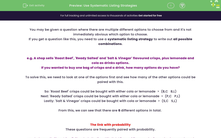You may be given a question where there are multiple different options to choose from and it's not immediately obvious which option to choose.
If you get a question like this, you need to use a systematic listing strategy to write out all possible combinations.
e.g. A shop sells 'Roast Beef', 'Ready Salted' and 'Salt & Vinegar' flavoured crisps, plus lemonade and cola as drinks options.
If you wanted to buy one bag of crisps and a drink, how many options do you have?
To solve this, we need to look at one of the options first and see how many of the other options could be paired with this.
So: 'Roast Beef' crisps could be bought with either cola or lemonade > (B,C B,L)
Next: 'Ready Salted' crisps could be bought with either cola or lemonade > (P,C P,L)
Lastly: 'Salt & Vinegar' crisps could be bought with cola or lemonade > (S,C S,L)
From this, we can see that there are 6 different options in total.
The link with probability
These questions are frequently paired with probability.
e.g. A shop sells 'Roast Beef', 'Ready Salted' and 'Salt & Vinegar' flavoured crisps, plus lemonade and cola as drinks options.
If someone randomly bought one bag of crisps and a drink, what is the probability they bought 'Roast Beef' crisps with a lemonade?
We know that there are 6 options in total and only one of these is the combination described in the question.
The probability of this choice will therefore be 1/6.
In this activity, you will employ systematic listing strategies to find all possible outcomes of linked events, which can then be used to calculate the probability of specific outcomes.
What do you need to make a list?
That's right - a pen and paper!








